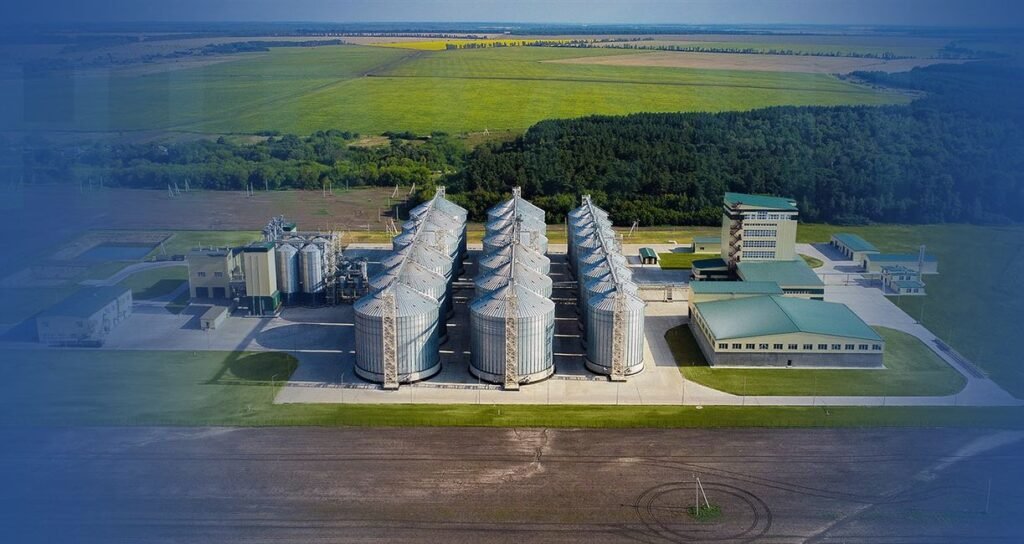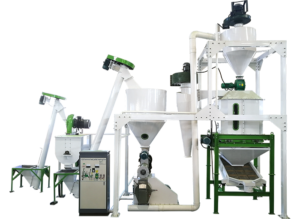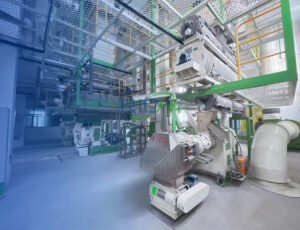
The animal feed industry plays a crucial role in supporting livestock production and, by extension, global food security. However, feed mills, including those with a capacity of 20 tons per hour (t/h), face increasing pressure to adopt environmentally friendly practices.
This article explores whether environmental protection investments in a 20t/h feed mill affect production efficiency and how to strike a balance between sustainability and productivity.
Understanding Environmental Protection Investments in Feed Mills
Environmental protection investments in feed mills typically include:
- Dust collection and filtration systems
- Wastewater treatment facilities
- Noise reduction measures
- Energy-efficient equipment
- Emission control systems
- Waste management and recycling infrastructure
These investments aim to reduce the environmental impact of feed production, comply with regulations, and improve the overall sustainability of operations.
Related post:chicken feed mill plant
Impact on Production Efficiency
The relationship between environmental protection investments and production efficiency is complex and multifaceted. While some investments may initially seem to hinder efficiency, many can actually enhance it in the long run.
Potential Negative Impacts on Efficiency:
- Initial Downtime: Installing new environmental protection equipment may require temporary production halts, potentially reducing short-term output.
- Increased Energy Consumption: Some environmental systems, such as dust collectors or wastewater treatment plants, require additional energy to operate, potentially increasing overall energy consumption.
- Maintenance Requirements: Environmental protection equipment needs regular maintenance, which can add to operational costs and potentially cause brief production interruptions.
- Space Constraints: Installing environmental protection equipment may take up valuable floor space, potentially limiting the area available for production processes.
Positive Impacts on Efficiency:
- Improved Air Quality: Dust collection systems not only reduce environmental impact but also create a cleaner working environment. This can lead to better equipment performance, reduced maintenance needs, and improved worker productivity.
- Water Conservation: Wastewater treatment and recycling systems can significantly reduce water consumption, leading to cost savings and more efficient resource use.
- Energy Efficiency: Many environmental protection investments, such as upgrading to energy-efficient motors or implementing heat recovery systems, can substantially reduce energy consumption and operating costs.
- Waste Reduction: Implementing proper waste management systems can lead to better resource utilization and potentially create new revenue streams through recycling or byproduct sales.
- Regulatory Compliance: Proactive environmental investments can help avoid costly fines, production shutdowns, or retrofitting requirements due to non-compliance with environmental regulations.
- Enhanced Reputation: A commitment to environmental protection can improve the feed mill’s reputation, potentially leading to increased market share and customer loyalty.
Case Study: Balancing Environmental Protection and Efficiency
Consider a 20t/h feed mill that invested in a comprehensive environmental protection upgrade:
- Installation of a state-of-the-art dust collection system
- Upgrade to energy-efficient motors and drives
- Implementation of a wastewater treatment and recycling system
- Noise reduction measures including equipment enclosures and vibration dampeners
Initial Impact:
- The installation process required a two-week production halt, resulting in a short-term production loss of approximately 6,720 tons (20t/h * 24 hours * 14 days).
- The total investment cost was $1.5 million.
Long-term Results:
- Energy consumption reduced by 15% due to more efficient equipment.
- Water usage decreased by 30% through recycling and conservation measures.
- Maintenance costs for production equipment decreased by 20% due to cleaner operating conditions.
- Worker productivity increased by 5% due to improved air quality and reduced noise levels.
- The feed mill avoided $200,000 in potential environmental fines.
- The company secured a major contract with an environmentally conscious customer, increasing annual sales by 10%.
In this case, while there was a short-term efficiency loss, the long-term benefits significantly outweighed the initial setbacks, ultimately enhancing overall efficiency and profitability.
Related post: pig feed mill
Strategies for Balancing Environmental Protection and Efficiency
- Phased Implementation: Instead of a complete overhaul, implement environmental protection measures in phases to minimize disruption to production.
- Integration with Scheduled Maintenance: Coordinate environmental upgrades with planned maintenance shutdowns to reduce additional downtime.
- Prioritize Dual-Benefit Investments: Focus on environmental protection measures that also improve efficiency, such as energy-saving equipment or water recycling systems.
- Employee Training: Invest in comprehensive training programs to ensure staff can efficiently operate and maintain new environmental protection systems.
- Continuous Monitoring and Optimization: Implement monitoring systems to track the performance of environmental protection measures and their impact on production efficiency, allowing for continuous optimization.
- Research and Development: Invest in R&D to develop innovative solutions that address both environmental concerns and efficiency improvements.
- Collaboration with Equipment Suppliers: Work closely with equipment suppliers to design and implement environmental protection solutions that are tailored to the specific needs and constraints of the feed mill.
Conclusion
While environmental protection investments in a 20t/h feed mill may initially pose challenges to production efficiency, they often lead to long-term benefits that can enhance overall operational performance. The key lies in strategic planning, phased implementation, and a focus on solutions that offer dual benefits in terms of environmental protection and efficiency improvements.
Feed mill operators must recognize that environmental protection is not just a regulatory requirement but a business imperative in today’s market. Customers, investors, and the public increasingly demand sustainable practices from all industries, including animal feed production.By carefully selecting and implementing environmental protection measures, feed mills can not only comply with regulations and reduce their environmental footprint but also improve their operational efficiency, reduce costs, and enhance their market position.
The initial investment and potential short-term disruptions should be viewed as necessary steps towards building a more sustainable, efficient, and competitive operation in the long run.Ultimately, the question is not whether environmental protection investments will affect production efficiency, but how feed mill operators can leverage these investments to drive both environmental sustainability and operational excellence. With careful planning and implementation, environmental protection and production efficiency can go hand in hand, creating a win-win situation for the business, its customers, and the environment.
For details please contact: pellet press
WhatsApp:86 138 3838 9622
Email:enquiry@richipelletmachine.com






